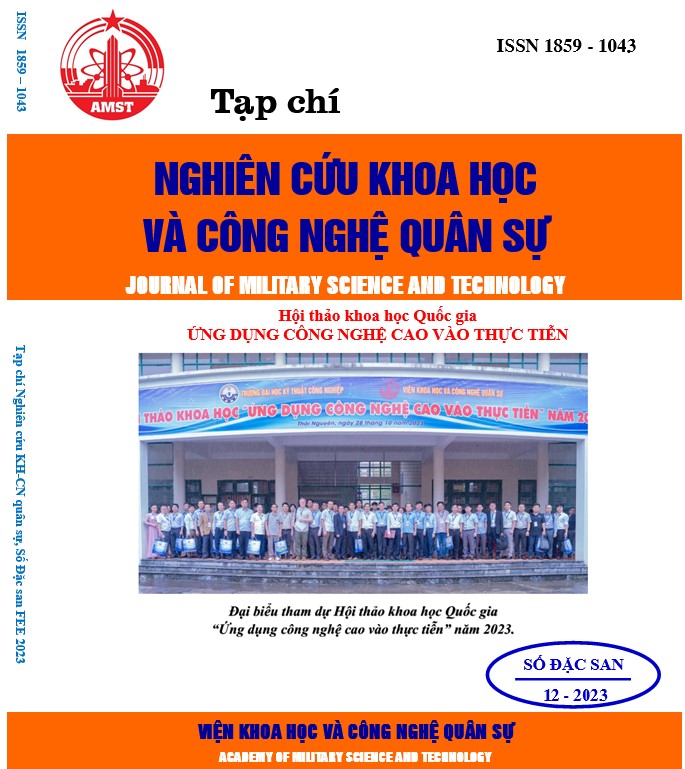Study some factors affecting the efficiency of treatment of 2,4-Dinitrotoluene (DNT) in water by UV-fenton method
330 viewsDOI:
https://doi.org/10.54939/1859-1043.j.mst.FEE.2023.209-215Keywords:
2,4-Dinitrotoluen (DNT); UV- fenton.Abstract
In this study, the influencing factors on the treatment process of 2,4-Dinitrotoluene (DNT) containing water using UV-Fenton process were evaluated in reaction time (0 - 60 minutes), including pH indicator, UV wavelength, molar ratio of H2O2/Fe2+, initial concentration of ferrous and the initial concentration of DNT. The results showed that at the initial concentration CoDNT = 100,37 mg/L, molar ratio of H2O2/Fe2+ = 20, CFe2+ = 1,75 mM, pH = 3, UV wavelength λ = 254 nm, the treatment efficiency on DNT containing water reached 100% after a reaction time of 60 minutes.
References
[1]. Xu, X., et al., "A comparative study on the treatment of 2,4-dinitrotoluene contaminated groundwater in the combined system: efficiencies, intermediates and mechanisms". Science of The Total Environment. 735: p. 139161, (2020). DOI: https://doi.org/10.1016/j.scitotenv.2020.139161
[2]. Xu, W., et al., "Optimization of organic pollutants removal from soil eluent by activated carbon derived from peanut shells using response surface methodology". Vacuum. 141: p. 307-315, (2017). DOI: https://doi.org/10.1016/j.vacuum.2017.04.031
[3]. Podlipná, R., B. Pospíšilová, and T. Vaněk, "Biodegradation of 2,4-dinitrotoluene by different plant species". Ecotoxicology and Environmental Safety. 112: p. 54-59, (2015). DOI: https://doi.org/10.1016/j.ecoenv.2014.07.026
[4]. Paca, J., et al., "Aerobic biodegradation of 2,4-DNT and 2,6-DNT: Performance characteristics and biofilm composition changes in continuous packed-bed bioreactors". Journal of Hazardous Materials. 163(2): p. 848-854, (2009). DOI: https://doi.org/10.1016/j.jhazmat.2008.07.037
[5]. Takdastan, A., et al., "Removal of dinitrotoluene from petrochemical wastewater by Fenton oxidation, kinetics and the optimum experiment conditions". SN Applied Sciences. 1(7): p. 794, (2019). DOI: https://doi.org/10.1007/s42452-019-0812-x
[6]. Chen, W.-S. and C.-P. Huang, "Decomposition of nitrotoluenes in wastewater by sonoelectrochemical and sonoelectro-Fenton oxidation". Ultrasonics Sonochemistry. 21(2): p. 840-845, (2014). DOI: https://doi.org/10.1016/j.ultsonch.2013.10.026
[7]. Quảng, Đ.S., et al., "Nghiên cứu đặc điểm phản ứng phân hủy 2,4-dinitrotoluen, nitro glycerin trong môi trường nước bằng tác nhân fenton". Vietnam Journal of Chemistry. 53(3): p. 348-351, (2015).
[8]. Nguyễn, V.H., et al., "The effectiveness of TNT yellow wastewater treatment by using Photo-Fenton process". Journal of Military Science and Technology. 88(88): p. 87-94, (2023). DOI: https://doi.org/10.54939/1859-1043.j.mst.88.2023.87-94
[9]. Nguyễn Văn Huống, P.S.T., Lê Minh Trí, Nguyễn Lê Tú Quỳnh, "Nghiên cứu xử lý TNT trong nước bằng hệ UV-fenton". Hóa học & Môi trường, (2022). DOI: https://doi.org/10.54939/1859-1043.j.mst.82.2022.98-104







